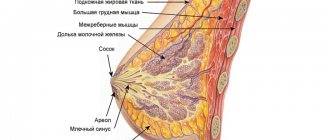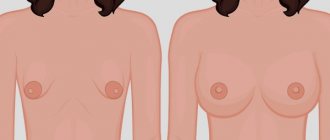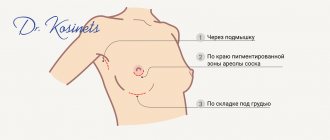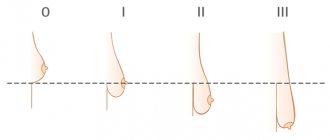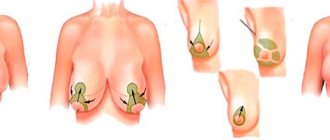Not only the beauty of her breasts, but also her ability to feed a newborn baby will depend on the natural anatomy of a woman’s nipples. Each representative of the fairer sex has a breast that has its own special attractiveness; there are differences not only in size, but also in relation to the shape and color of the nipples. Such differences are normal and should not bother a woman, since such breast characteristics depend on genetics, race, and some other indicators.
Nipple structure
If we consider the structure of the nipple, it is formed in the form of a protrusion above the mammary gland. It is an accumulation of skin, and it is especially delicate and sensitive due to the accumulation of receptors, as well as close contact with nerve endings, including the intercostal system.
The anatomy of the nipples suggests a relationship with halos, which may have a darker shade. On the surface of the areola there are small tubercles, which are sources of secretion of special compounds that prevent drying out and damage to the nipples. Their functions are especially important during breastfeeding.
Nipple retraction on one side
A change in the shape of the nipple of the mammary gland, caused by tissue changes in the mammary gland, is called acquired nipple retraction. The nipple, raised above the skin, begins to pull inward, change position, and finally it is completely hidden, taking on the appearance of a narrow fold.
Unlike an inverted nipple, acquired retraction is not accompanied by its return to a “protruding position” during stimulation. Nipple retraction can be caused by age-related changes, milk duct ectasia, or breast cancer.
Be sure to consult a doctor if you are faced with a problem such as acquired nipple retraction. Nipple retraction may be an early sign of malignancy.
A mammogram, breast ultrasound, or breast magnetic resonance imaging (MRI) can help determine the cause of a change in nipple shape.
Nipple color and what it depends on
The skin tone of the nipples and adjacent areola can be different, since each organism has its own certain amount of hormones responsible for skin color and pigmentation. That is why the color of the nipples can change over time, for example, in girls they are often light pink, during puberty they darken a little, and during pregnancy the shade can change in any direction, although darkening of the tissue is more often observed.
The fundamental factor in the color of the outer part of the mammary gland is race, genetic predisposition, and hormonal background.
How hormones affect breast development
The structure of the breasts in women directly depends on the level of hormones. The entire cycle of breast development, from puberty to menopause, is influenced by about 15 hormones.
Let's look at the most important ones:
- Estrogens – stimulates the growth of connective tissue cells and the development of mammary glands.
- Progesterone - increases the number of alveolar cells, affects the growth of glandular tissue.
- Prolactin causes the division and growth of new epithelial cells. It has a very important role during lactation, ensuring the fullness of milk.
- Insulin - stimulates the growth of new cells caused by the action of prolactin, glucocorticoids and progesterone.
The shape of the nipples and what it depends on
The normal anatomy of the nipples suggests differences in the shape and size of the protrusions themselves, and this should not bother a woman, since each woman’s breasts have individual characteristics. If we classify nipples by shape, we can distinguish the following types:
1. Convex or protruding. They protrude significantly above the breasts; some women experience discomfort, since the nipples stand out especially under clothing; 2. Normal. The conditional norm is considered to be an average elevation above the surrounding tissues; a natural increase occurs with changes in temperature and emotional arousal; 3. Flat. According to some reports, flat nipples are more common in women. They are almost at the same level with the areola, but under certain influences that affect sensitivity, they rise slightly 4. Retracted. If retraction develops from birth, then during puberty or after childbirth a change in shape is possible, since the anatomy of the nipples suggests some age-related changes. During the breastfeeding period, a specialist may be required to establish lactation and help the baby adapt to the mother’s breast. In case of sudden changes in the breast, you should contact mammology for diagnostic measures. 5. Versatile. Nature allows some asymmetry and it may affect the nipples. This is not considered an abnormality, but sometimes requires observation, especially if there are strong differences, for example, one nipple is inverted and the other is protruding.
In addition to the shaped difference, there are several options for the direction of the nipples. They can be straight, have opposite lines, or point down, which is more common in women over 40 years old. These indicators vary for every woman, especially for those who have given birth and nursed their babies for a long time. For the anatomy of the nipples, changing direction is natural, but there are some techniques that help support the skin, for example, proper attachment of the baby when feeding, care, massage, special underwear, and so on. The shapes and sizes of the outer part of the breast may differ from generally accepted standards presented in the modeling business and other fields. Only this fact should not become the reason for surgical intervention, since the specialist can also propose other programs to change the size and shape of the nipples, if this is really necessary.
Appearance
Mammary glands are present not only in women, but also in men. The anatomy of the female mammary gland is initially completely identical to the male anatomy, since the mammary glands are formed in both sexes during prenatal development.
Before puberty, the difference is completely unnoticeable, and only during the period of hormonal changes do the size, shape and structure of the female breast change.
Form
The mammary glands in women look like two symmetrical convex hemispheres. The location of the mammary glands in women is at the level of the third to sixth pair of ribs. Just below the center of the roundness is the nipple, surrounded by the areola.
There is also a generally accepted classification of breasts depending on their shape:
- discoid - a small gland with a wide base,
- hemispherical - diameter and height are approximately equal,
- pear-shaped – the height significantly exceeds the base,
- mastoid - similar in parameters to the pyriform, but the gland itself is more strongly lowered, the nipples are located lower and directed downwards.
Size
You cannot take any specific size as the norm, since it develops individually for each woman.
The average is considered to be a girth of 80 to 85 cm. A slight asymmetry, when one gland is slightly larger, can be considered normal.
The size of the mammary glands depends on several factors:
- amount of adipose tissue:
- the size of the gland itself,
- full of milk.
The weight of the mammary gland in a nulliparous girl is on average 200 g; during breastfeeding it can reach 800-900 g. After the end of lactation, the gland decreases in size. Size does not affect the amount of milk and the possibility of lactation.
The hormonal background of the female body affects the size of the mammary gland; its appearance can change depending on the phase of the menstrual cycle and change with age.
Nipples
The areola (a pigmented round area of skin with a diameter of 3-5 cm) is located slightly below the middle of the breast gland, approximately at the level between the fourth and fifth pair of ribs. In its center there is a nipple, which has a flat-cylindrical or cone-shaped shape. The color of the areola and nipple varies from light pink in nulliparous and fair-skinned women to dark brown or brown in parous women or in women with darker skin. In nursing women with a large bust, the diameter of the areola can exceed 10 cm, and the pigmentation of the areolar-nipple area becomes more intense during this period.
The structure of the nipple: the milk ducts come out and form the nipple, around which the areola is located. Under the skin of the areola are 10 to 15 vestigial areolar glands and a small number of sebaceous and sweat glands. There are small holes on the surface of the nipple, which are the exit of the milk ducts, through which milk flows.
The skin on the nipples and areola is very thin and covered with small folds that resemble wrinkles.
Bundles of smooth muscle cells located on the areola and nipple contract when exposed to cold or touch, causing the nipple to shrink and slightly increase in size.
Functions of the nipple
More often, breasts are one of the attractive parts of a woman’s body, but, nevertheless, its main function, inherent in nature, is feeding offspring. Milk flows through the nipples, passing through the ducts and previously formed and accumulated in the alveoli.
The anatomy of the nipple means that this part of the breast is highly sensitive. It has many receptors, nerve endings and the finest tissues. If we consider the additional functions of the outer part of the chest, its features, we can highlight:
• Additional sexual stimulation, and touching can bring pleasure to both partners; • Changes in shape can signal temperature changes in the body. When there is cold or chills, the nipples harden and change shape; • The hormonal state of a woman is reflected in the configuration and color of the nipple, and this can become a signal for additional examination; • An attribute of attractiveness, which for some is one of the most important in a woman’s appearance.
The characteristics of the breast largely depend on physiological, age and genetic characteristics, so each lady finds her own functions for her.
General data and interesting information
In their desire to acquire ideal, by generally accepted standards, breasts, some women make irreparable mistakes. To avoid such troubles, you should have a superficial understanding of the anatomy of the nipples and adhere to the following recommendations:
1. Correctly selected underwear is a good prevention of sagging breasts and changes in the direction of the nipples; 2. Surgical correction of the soft tissues of the glands involves changing the protruding parts, otherwise proportionality is lost, for example, a large breast and a small nipple; 3. Small nipples are not an obstacle or serious difficulty in breastfeeding, nor are inverted or large nipples. The situation can be corrected by attachments and specialist consultations; 4. It is necessary to select appropriate cosmetics specifically for nipples and not only during lactation. This will help prevent dryness and cracks, which will only have a positive effect on the condition of the skin; 5. There are temporary changes in the nipples that occur due to hormones. This may be the appearance of hair, tubercles, darkening, or increase in size. There is no need to be afraid of such phenomena, they are often caused by natural restructuring of the body, but contacting a mammologist will be useful.
Every woman should not only worry about the attractiveness of her breasts, including the shape, color, and size of the nipples, but also take care of the health of the mammary glands. This also applies to a meaningful attitude towards surgical interventions, the feasibility of which should always be discussed with a specialist.
Anomalies
There are breast anatomy with congenital or acquired pathology.
Macromastia is a pathological increase in the size of the mammary gland that occurs after disruption of the endocrine system during pregnancy or puberty.
Polymastia - a malfunction during intrauterine development of the fetus leads to the appearance of additional mammary glands, which can be located on the chest and abdomen from the armpits to the groin area. With polymastia, there is a high chance of developing oncology, so it is recommended to remove its manifestations.
Polythelia is a congenital genetic pathology expressed by an increased number of nipples located along the mamillary lines of the body. Accessory nipples are often mistaken for moles. This anomaly can occur in both women and men.
Amastia is a rare abnormality in which one or both mammary glands fail to develop. This pathology can be found in infants of both sexes. It does not pose a threat to life, but if the pathology is detected in a girl, then breastfeeding will be impossible for her in the future.
A flat or inverted nipple in a woman is not a pathology, but it does cause some inconvenience during breastfeeding. A small plastic surgery will help correct the shape of the nipples.
